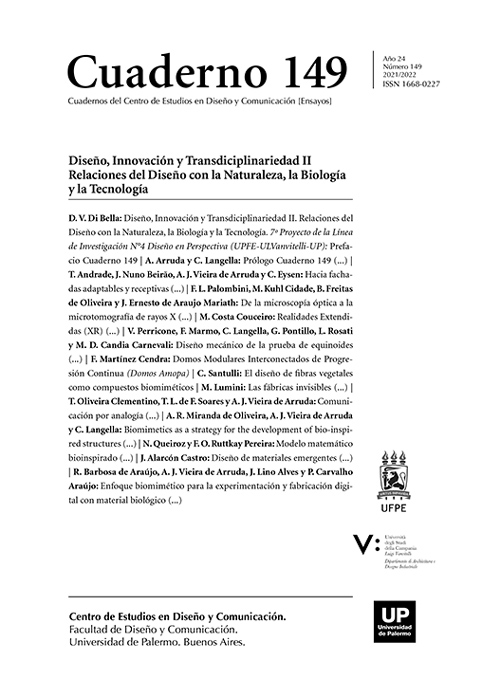Realidades Extendidas (XR). Evolución Cognitiva y Analogías Biológicas en la Comunicación Científica
Abstract
Using development research (Lobo & Couceiro, 2019) as a pretext, where digital and analog realities are integrated, this article presents some less common aspects of bionic research, Extended Realities (XR) originating from the Cyborg culture. We are currently developing content, methods and technologies for the dissemination of architectural and artistic heritage classified by UNESCO1 , exploring the intersections of natural and artificial intelligence. Foresight exercises are also developed on how cultural dissemination will be carried out and how the media will be used in the perpetuation of memory and in the progress of human knowledge.
References
Bryson, B. (2004). A short history of nearly everything. Toronto: Anchor Canada. pp. 453-458.
Chomsky, N. (Nov. 29, 2019). Noam Chomsky: Language, Cognition, and Deep Learning | Lex Fridman Podcast #53[Video]. YouTube. https://youtu.be/cMscNuSUy0I
Couceiro, M. C. (2014). Learning (r) evolution - achieving up consistency between the real and virtual world. Session 4. ISCTE IUL, Lisbon: Aproged - associação dos professores de desenho e geometria descritiva.
Couceiro, M. C. (2006). Architecture as human phenotypic extension - an approach based on computational explorations. SIGRADI 2006: post digital: el factor humano. Santiago de Chile, University of Chile: SIGRADI 2006 - University of Chile, 56-60.
Damasio, A. (1994). Descartes´ Error: Emotion, Reason and The Human Brain. Ed. Crítica.
Dore, C. and Murphy, M. (2012). Integration of Historic Building Information Modeling and 3D GIS for Recording and Managing Cultural Heritage Sites, 18th International Conference on Virtual Systems and Multimedia: “Virtual Systems in the Information Society”, 2-5 September, 2012, Milan, Italy, pp. 369-376. doi:10.21427/e7sy-rt81
Dawkins, R. (1982). The extended phenotype: The gene as the unit of selection. Oxfordshire: Freeman.
Forum, d’Avignon and TERA, consultants (eds) (2014). The economic contribution of the creative industries to EU GDP and employment - Evolution 2008-2011, TERA Consultants, Paris.
Gatti, R. C. (2006). A conceptual model of new hypothesis on the evolution of Biologia, Volume 71, Issue 3, pp. 343-351.
Harshal, A.; Sonar, H. A.; Gerratt, A. P.; Lacour, S. P. and Paik, J. (Sep 23, 2019). Soft Robotics. Online Ahead of Print: http://doi.org/10.1089/soro.2019.0013
Hotz, G. (2020, Oct 22). George Hotz: Hacking the Simulation & Learning to Drive with Neural Nets | Lex Fridman Podcast #132 [Video]. YouTube. https://www.youtube.com/watch?v=_L3gNaAVjQ4
Renshaw, T.; Sonnenfeld, N. and Meyers, M. (2016). ‘Fundamentals for a Turing Test of Virtual Reality’, in, (eds), Proceedings of the Human Factors and Ergonomics Society 2016 Annual Meeting, SAGE Journals, pp. 2113-2117.
Rogan, J. and Fridman, L. (Oct 24, 2018). Joe Rogan Experience #1188 - Lex Fridman [Video]. YouTube. https://youtu.be/j5FOumrXyww
Lobo, R. & Couceiro, M. (2019). Caminhos Futuros do Património Desaparecido. Colóquio Internacional sobre reconstituições 3D de património desaparecido, Coimbra, Centro de Estudos Sociais.
Milgram, P. and Kishino, F. (1994). A taxonomy of Mixed Reality Visual Displays. IEICE Trans. Inf. & Syst. Vol. E77-D, No.12, (pp.1321-1329).
Moore, G. (1965). Cramming more components onto integrated circuits. Electronics 38(8), 114-117.
Musk, E. (Aug 29, 2020). Neuralink: Elon Musk’s entire brain chip presentation in 14 minutes. [Video]. YouTube. https://www.youtube.com/watch?v=CLUWDLKAF1M
Polanyi, M. (1966). The Tacit Dimension, University of Chicago Press, Chicago, 4.
Toffler, A. (1970). Future shock. New York: Bantam Books.
Los autores/as que publiquen en esta revista ceden los derechos de autor y de publicación a "Cuadernos del Centro de Estudios de Diseño y Comunicación", Aceptando el registro de su trabajo bajo una licencia de atribución de Creative Commons, que permite a terceros utilizar lo publicado siempre que de el crédito pertinente a los autores y a esta revista.


